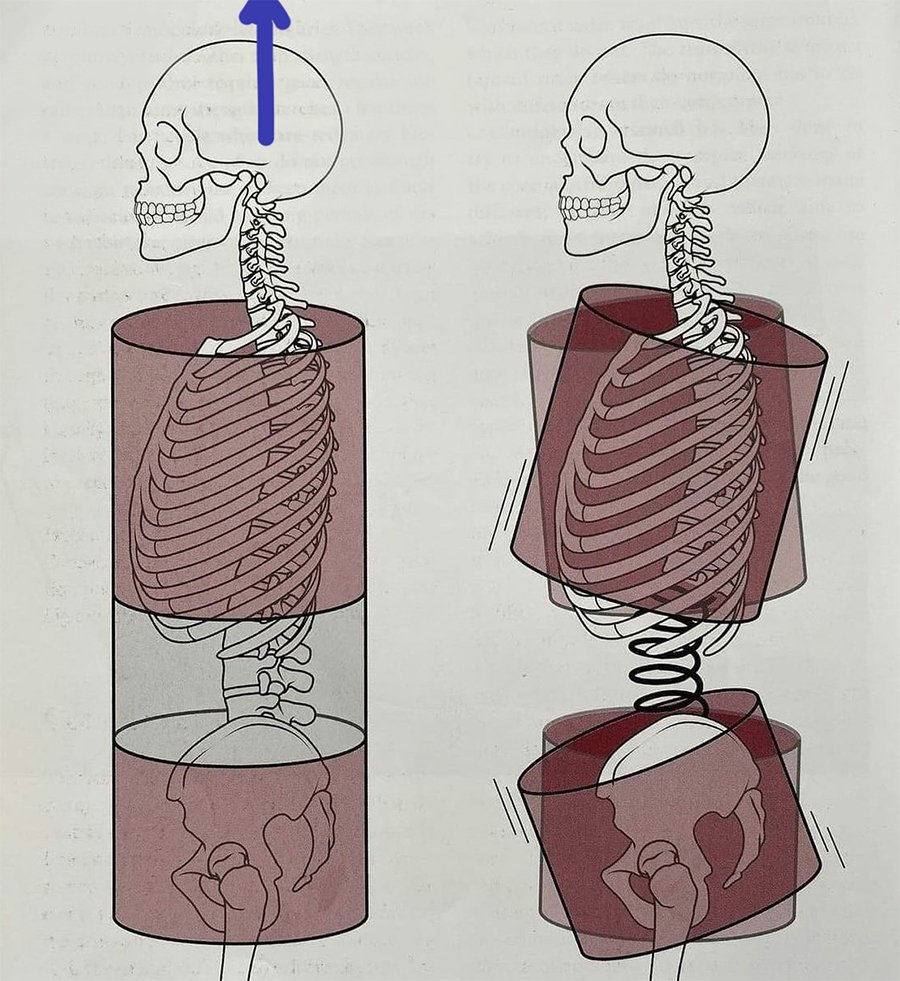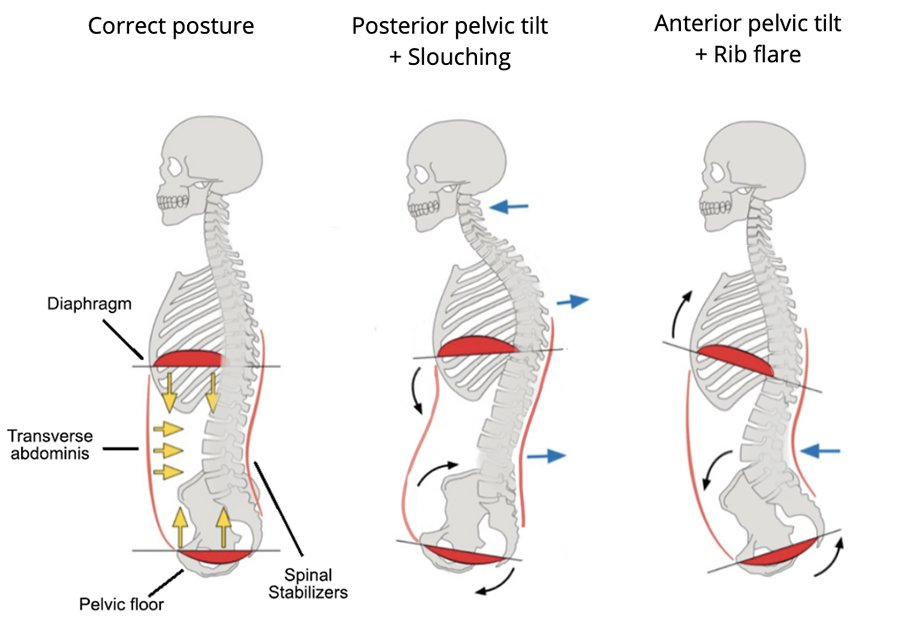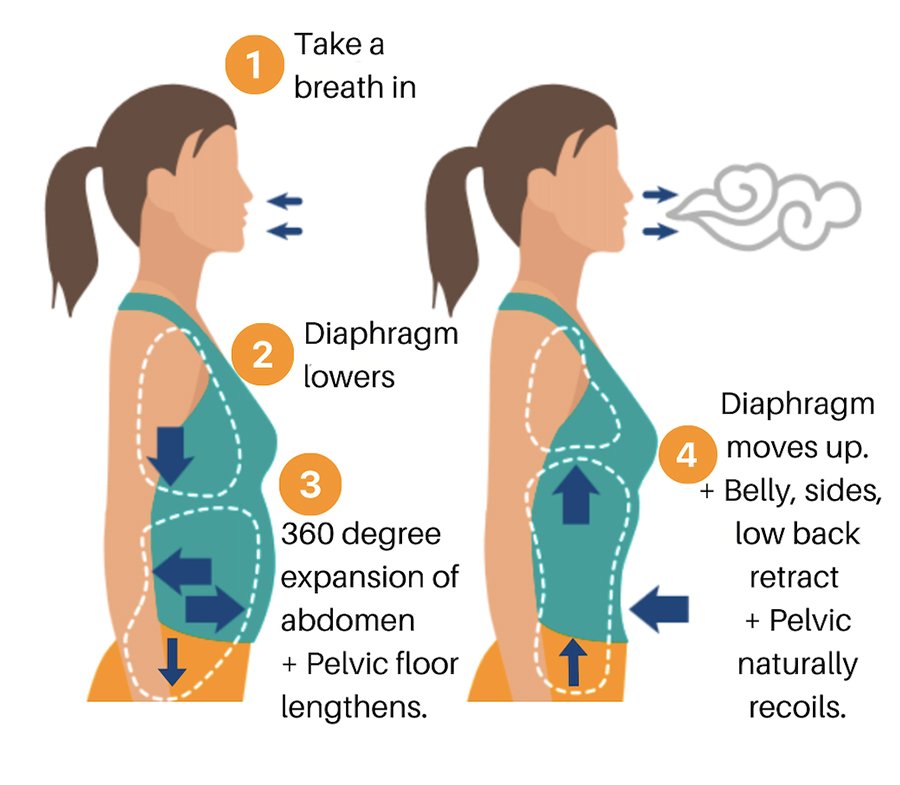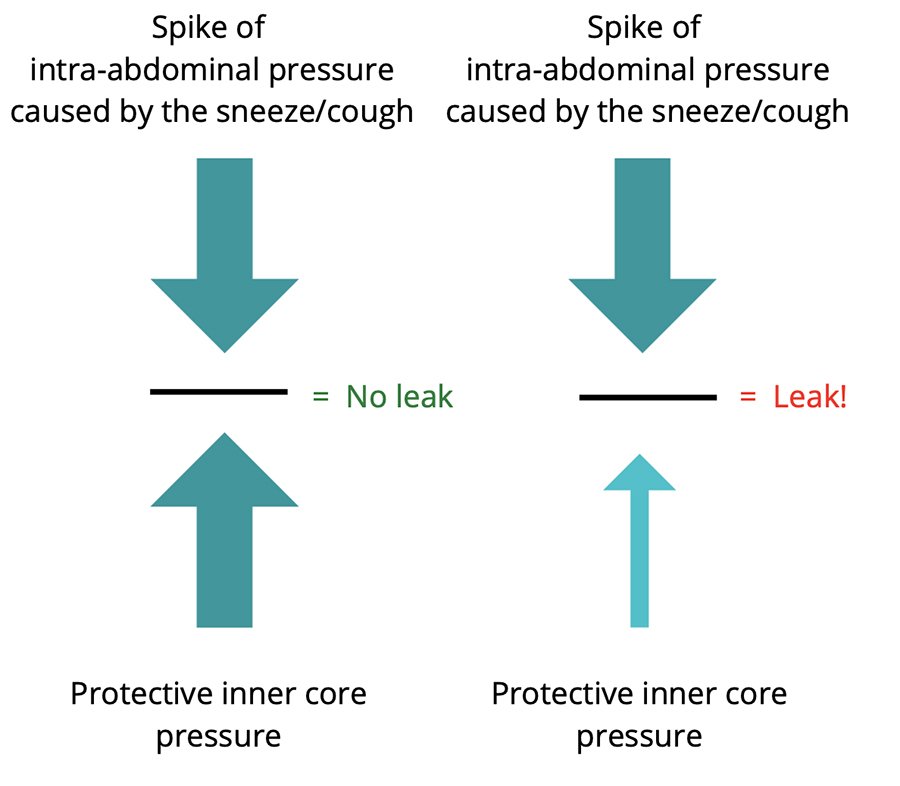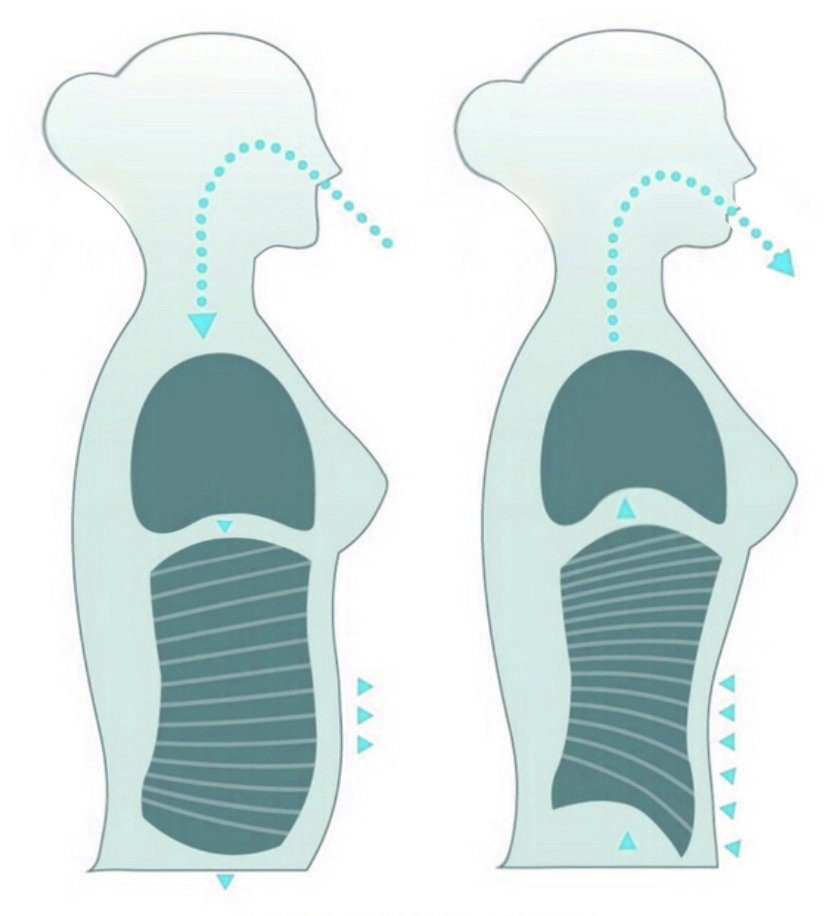Peeing while sneezing, laughing, or coughing is called stress incontinence. This is NOT something you have to live with, regardless of weather you’ve had children or not.
Leaking occurs when there is increased pressure in the abdomen and pelvic region, causing increased pressure on your bladder that resulting in urine leakage.
Think about the last time you sneezed, coughed or “belly laughed”.
Do you remember feeling some pressure in your stomach?
If you leaked, your pelvic floor muscles were unable to overcome the pressure in your abdomen due to these events, but it’s not just your pelvic floor’s fault!
Let’s look at 5 common reasons why you may pee when coughing, sneezing, or laughing…
Poor alignment
#1 - Why you may pee when you cough, sneeze, or laugh
Take a minute to analyze your alignment.
Is your rib cage stacked over your pelvis?
Is your rib cage stacked over your pelvis?
Image source: unknown
When you have your “rib cage over your pelvis,” your diaphragm and pelvic floor are aligned, and your core can best control a sudden increase of the intra-abdominal pressure.
When you have your “rib cage over your pelvis” your diaphragm and pelvic floor are aligned, and your core can best control a sudden increase of the intra-abdominal pressure
This alignment allows your inner core muscles to create optimal force-generating abilities to keep you dry.
But if your pelvic tilt is too great or your ribs are flaring, then the diaphragm and pelvic floor lose their optimal positioning, and your inner core can’t respond effectively to the increased pressure.
Most women think that the solution lies in “kegels” when thinking of pelvic floor issues. However, pelvic floor dysfunction is a whole body issue that requires your muscles to work collectively for optimal function (more about this below).
As crazy as it may sound, some of my students improve their pelvic floor function by simply correcting their alignment!
Wrong breathing pattern at rest
#2 - Why you may pee when you cough, sneeze, or laugh
Breathing is an autonomic function. We don’t have to consciously think about breathing, so we don’t often consider HOW we breathe.
Breathing dysfunction can occur due to stress, anxiety, pregnancy, poor awareness, poor posture, or because you wear tight high-waisted pants, or suck your tummy in all day long.
The diaphragm and pelvic floor work together as a team. If the diaphragm doesn’t work properly, neither does your pelvic floor!
Now that you’ve analyzed your posture let’s look at your breathing.
Place a hand on your tummy and a hand on your chest. Tune in and check your breathing pattern at rest. Simply breathe normally.
When you breathe in and out, what is moving?
Is your chest hand the only one moving?
Is your belly moving at all?
Can you feel some movement in your lower ribs, abdomen, and back?
Are your shoulders moving?
Many of you will feel the inhale into the chest:
If that’s your case, your upper ribs and shoulders move up to assist the inhale, and your belly inflates as you breathe out.
This leads to increased tension in the accessory breathing muscles (especially the neck and upper back muscles), puts the pelvic floor/diaphragm synchronization out of whack, and increases your chance of developing pelvic floor dysfunction.
(Re)learning how to breathe through the belly, lower ribs, and back (think 360 degrees) instead of shallow chest breathing is key to improving your pelvic floor function.
When we take a breath in, the diaphragm descends. Simultaneously, the pelvic floor lowers, and our tummy expands to receive the abdominal content.
The pelvic floor and your deep abdominal muscles are stretched during the inhale, like a rubber band.
They have elasticity, and they will both rise on the exhale to help stabilize the spine and pelvis.
It can take some time (and practice!) to retrain our breathing pattern at rest, to get your breathing out of your chest into your entire abdominal cavity.
Wrong breathing strategies when sneezing/coughing
#3 - Why you may pee when you cough, sneeze, or laugh
Time to do the “Cough Test”!
Stand up straight
Place your hands on your lower tummy.
Fake a cough.
What did you notice?
Did your lower tummy inflate or pull in when you coughed?
The “cough test” - Image source: St Michael’s Hospital
If your lower tummy bulged out when you did the cough test, then your cough isn't pushing everything up.
In this situation, the pressure is also going downward against your pelvic floor and forward against your ab wall, which is why many women leak when they cough!
This creates excessive downward force on the pelvic floor, and decreases your inner core’s ability to respond to the cough.
This applies to sneezing too.
A lot of women, stressed about the sneeze coming, tend to:
Brace or push their belly out. This prevents the lower belly from responding to the sneeze - which should be bringing everything up and in.
Plug their nose when sneezing. In this case, the pressure in your abdomen has nowhere to go but downward, which increases your chance of leaks. So let the sneeze escape!
Regardless of if you cough, laugh, or sneeze, your tummy should pull in, and you should be creating an upward force.
Think of it next time you feel it coming on.
Weak inner core muscles
#4 - Why you may pee when you cough, sneeze, or laugh
Now that you’ve passed the cough test, how powerfully can your inner core push back against the spike of intra-abdominal pressure created by the cough or sneeze?
If the pressure above is greater than the protective inner core pressure below matching it, you’ll leak!
There are two main types of weak pelvic floors which require different treatments:
1• Hypotonic pelvic floor
A hypotonic pelvic floor lacks tone.
The pelvic floor muscles are too long and too weak.
Like a saggy hammock, they can’t adequately support the pelvic organs and do their job.
2• Hypertonic pelvic floor
A hypertonic pelvic floor has too much tone.
Unlike a hypotonic pelvic floor, the pelvic floor muscles are too short and too tight. Don’t mistake this for a strong pelvic floor. Holding too much tension makes the pelvic floor weak (tight doesn’t equal strong!) and unable to function properly.
Like a ridged hammock, unable to cradle you.
If your pelvic floor muscles are too tight, they can’t relax or contract to work as they should. To correct this, the muscles then need to relax and return to their normal resting length, so they recover and prepare to contract again.
Hammock analogy - hypotonic pelvic floor and hypertonic pelvic floor
Note that the pelvic floor muscles don’t work in isolation - they are part of a system that includes your diaphragm, pelvic floor, deep abs, and spinal stabilizers.
Let's move away from the idea that to improve our pelvic floor function, we need to isolate the pelvic floor muscles.
That’s not how the core system works. That's not how our BODY works!
Our breath connects our entire core. That’s why core exercises based on abdominal breathing are the best exercises to improve inner core function.
The goal is to enhance the relationship between core elements to balance and rebuild strong and functional foundations.
Wrong timing
#5 - Why you may pee when you cough, sneeze, or laugh
Sometimes, even with a healthy pelvic floor, the inner core muscles can’t react quickly enough to push upward against the downward force generated by the sneeze.
Retraining the inner core muscles to fire before the pressure increase is key.
Practicing the “Knack” may help.
The “Knack”
The Knack is a well-timed pelvic floor contraction before coughing or sneezing.
The goal is to counter the downward pressure caused by the sudden increase in intra-abdominal pressure.
So, pull up your pelvic floor just before you cough or sneeze. Again, it is the timing of this contraction that is important.
This will help support your bladder and other pelvic organs and engage your lower abs.
The Knack works optimally if your posture is correct, and if you pass the cough test ;)
You can stop peeing when coughing, sneezing, or laughing
Retrain your body and brain.
As you resynch the whole core system, develop more awareness, and work on your posture your body will progressively re-build the reflexive response of the inner core.
Most of us can restore proper pelvic floor function and enjoy a leak-free life!!
I’m passionate about pelvic health and empowering women with knowledge!
Please leave a comment below if you found this article helpful, like it, and share it with your friends.
Many Mamas out there may need it. Through education and conversation, we can overcome this issue many of us suffer with.
Are you ready to take advantage of the training options I offer?
Immediate Postpartum Program - From Birth to 8 weeks PP
Core Rehab Program (after 8 weeks PP) - Better Body after Baby program
Membership Program - Follow the training I use for my own fitness ($29.90/ month – no string attached)



